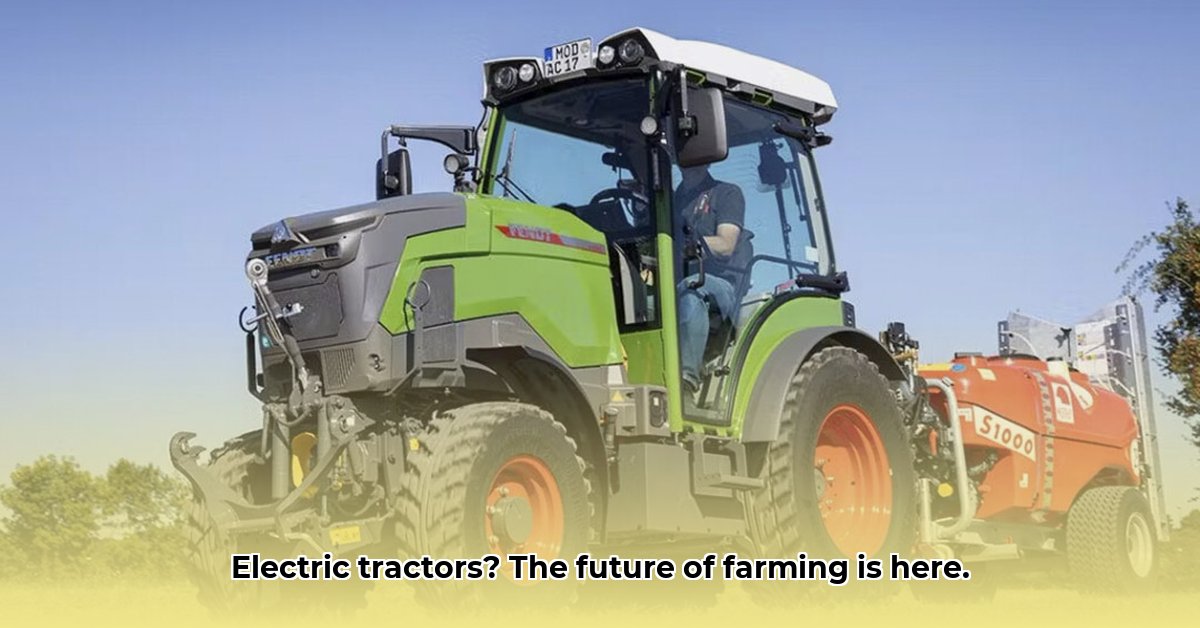
The Fendt e100 Vario represents a significant leap towards sustainable agriculture. This electric tractor, along with its variant the e100 V Vario, offers a powerful, efficient, and remarkably quiet alternative to traditional diesel models. For more on autonomous tractors, see this helpful resource. While some technical specifications vary across sources, the core benefits of reduced emissions and quieter operation remain undeniable. This review analyzes the tractor's performance, environmental impact, economic viability, and the challenges of widespread adoption.
Power and Performance: A Silent Revolution
The Fendt e100 Vario's power stems from its 100 kWh battery pack (consistent across sources). This provides sufficient energy for a full day's work under typical conditions, ranging from light harrowing to heavy plowing. Its electric motor delivers consistent torque, crucial for various agricultural tasks. Multiple operating modes – Eco, Dynamic, and Dynamic+ – allow farmers to optimize energy consumption based on workload. For example, Eco mode is ideal for lighter tasks, while Dynamic+ is better suited for heavy plowing. The absence of a noisy diesel engine is a significant advantage, reducing noise pollution and enabling extended working hours, especially in environmentally-sensitive areas. Isn't quiet operation a desirable feature for both farmers and their neighbors?
Environmental Impact: A Greener Field
The Fendt e100 Vario's environmental impact is substantial. Powered by renewable energy sources like solar or wind, operational carbon emissions are effectively zero, contributing significantly to a farmer's sustainability goals. Reduced noise pollution further benefits the environment and surrounding communities. However, a comprehensive life-cycle assessment is crucial, considering the environmental impact of battery production, lifespan, and eventual recycling. Ongoing research is essential to fully quantify the long-term environmental benefits.
Economic Considerations: Weighing the Costs
While the initial purchase price of a Fendt e100 Vario is higher than comparable diesel models, long-term cost savings are significant. Eliminating diesel fuel costs and reducing maintenance needs (due to the simpler electric motor) can offset this initial investment over time. The return on investment (ROI) is highly farm-specific, influenced by factors like farm size, workload, energy prices, and government subsidies or leasing options. These financial incentives can significantly affect the overall affordability and financial attractiveness of transitioning to electric tractors.
Infrastructure and Adoption: Overcoming Hurdles
Widespread adoption faces several key challenges. Firstly, sufficient charging infrastructure, particularly in rural settings, is crucial. While AC charging at home or in a barn is feasible, DC fast charging is essential for optimal efficiency. The absence of readily available fast chargers is a significant hurdle. Secondly, the current operational range of 4-7 hours under partial load may be insufficient for large-scale farms. Range extender technologies, combining electric and alternative power sources, are potential solutions under development.
Future Prospects: A Sustainable Future
The future of electric tractors like the Fendt e100 Vario is promising. Advancements in battery technology are expected to increase energy density for longer run times and extend battery lifespan, reducing replacement frequency. Government support through subsidies and incentives for renewable energy integration will accelerate adoption. Collaboration between manufacturers, policymakers, and farmers is essential for creating a supportive ecosystem for widespread adoption.
Preliminary Specifications Comparison:
| Feature | Fendt e100 Vario (Estimate) | Fendt e100 V Vario (Estimate) | Notes |
|---|---|---|---|
| Power Output (kW) | ~70-90 (unconfirmed) | ~70-90 (unconfirmed) | Specifications vary across sources. |
| Battery Capacity (kWh) | 100 | 100 | Consistent across sources. |
| Typical Operating Time (hours) | 4-7 (partial load) | 4-7 (partial load) | Dependent on workload and conditions. |
| Dimensions (m) | (Data unavailable) | (Data unavailable) | Requires additional research. |
Note: The data above is preliminary and requires further verification.
Key Takeaways:
- Environmental benefits are significant, but a complete life-cycle assessment is needed.
- Economic viability depends on multiple factors, and government incentives play a crucial role.
- Widespread adoption requires substantial improvements in charging infrastructure and operational range.
This review provides a comprehensive overview of the Fendt e100 Vario, highlighting its potential and the challenges ahead in the transition to sustainable agricultural practices. Further research is needed to solidify some of the preliminary data points, but the overall trajectory points towards a greener future for farming.